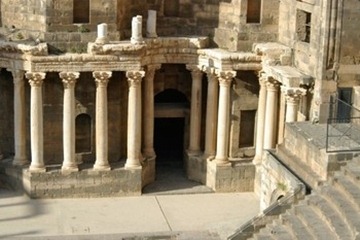Situated in the vast Hawran plain, about 145 kilometers south of Damascus, Bosra is an extremely ancient city. It bore the name Buhora during the Nabatean Era, but during the Hellenistic period, it was known by the name of Bustra.
 Later the Romans took an active interest in the city, and at the time of the Emperor Trajan it was made the capital of the Province of Arabia (in 106 B.C.) and was called Neatrajana Bustra.
Later the Romans took an active interest in the city, and at the time of the Emperor Trajan it was made the capital of the Province of Arabia (in 106 B.C.) and was called Neatrajana Bustra.
The city witnessed its greatest period of prosperity and expansion then, became a crossroad on the caravan routes and the official seat and residence of the Imperial Legate.
After the decline of the Roman Empire, Bosra played a significant role in the history of early Christianity. It was also linked to the rise of Islam, when a Nestorian monk called Bahira, who lived in the city, met the young Mohammad (the prophet) when his caravan stopped at Bosra, and predicted his prophetic vocation and the faith he was going to initiate.
The Roman amphitheater, which has been miraculously preserved contains 15 000 seats and its stage is 45 meters in length and 8 meters in depth. It has been designed so that all the audience can hear the actors without the use of any special equipment. The theater has been renovated and restored, especially its columns. There is a large area in front of the stage that might have been used for circuses or gladiatorial matches.
Bosra also contains impressive features such as Christian ruins, several old mosques palatial Roman baths, monumental gates and some fine Corinthian columns.
The Mosque of Omar is the only mosque surviving from the early Islamic period to preserve its original facades, and all its columns remain in place.
The al Khidr Mosque is one of Bosra's oldest Islamic structures. Built out of black basalt in 1134 on the site of an earlier mosque, its 12-meter-high minaret was built over a meter away from the mosque.
The al Mabrak Mosque, which recalls a visit by the Prophet Mohammed to Bosra, is in the northeast outskirts of the city.
It is also famous for the Roman bathes in addition to the Manjak Hammam, which dates back to 1372; it is a prototype of Mamluk architecture.
Head of Bosra Council, Wael Mefleh, said the city is witnessing an accelerating development economically and demographically thanks to the sector of tourism.
The city received 257,677 visitors in 2010 compared to 229,855 in 2009, according to Head of Antiquities Department of Dara'a , Wafaa al-Oudeh.
Al-Oudeh referred to the historical and demographical aspect of the ancient city which was inhabited by Canaanites, the Amorites, Aramaeans, the Nabateans, Ghassanids and the Islamic civilization since its establishment in the 14th century B.C., which makes it an attraction to historians, archeologists as well as tourists.
The archaeological City of Bosra has been declared a UNESCO World Heritage Site since 1982. Every other year, Ministry of Tourism holds Bosra International Folkloric Festival in the main theater with the participation of Arab and foreign countries.
Author:
R. Milhem | Source: Global Arab Network [February 14, 2011]